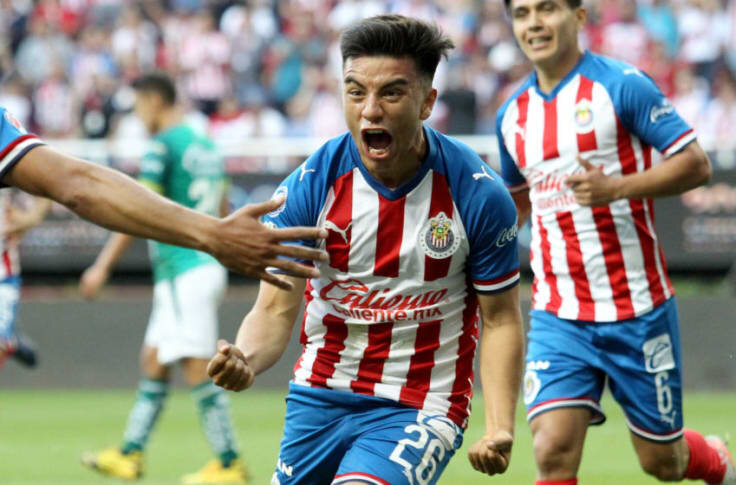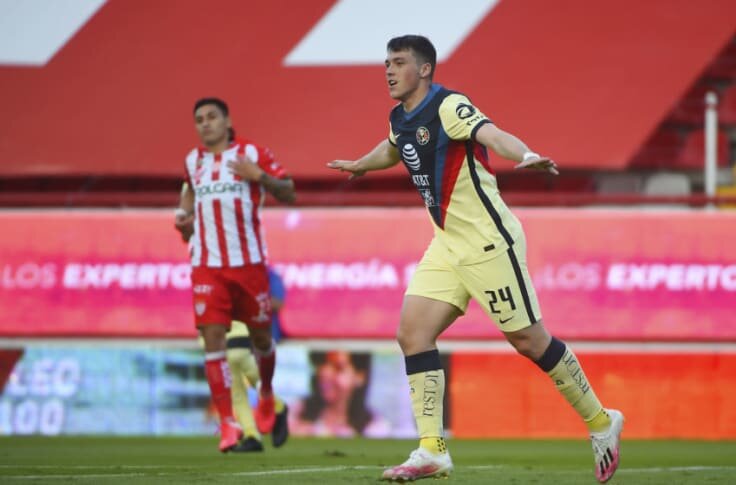Fernando Beltran – Chivas’ press-resistant maestro

Fernando Beltran was enthralled by Barcelona’s Andres Iniesta as the Spaniard was a creative force that inspired the Mexican. Beltran was first turned down by a club when he was 12 before Chivas’ scouts found him as an attacking player, honing his defensive ability before unleashing him as a deep-lying playmaker. Matias Almeyda gave him his debut as the two have formed a bond that has endured before he contemplated leaving the club when Tomas Boy managed the team and did not see his value. Luis Fernando Tena then reinvigorated his passion for Chivas as Beltran has responded with some controlling performances as one of the Liga MX’s best deep-lying midfielders.
"When I was little I used to watch many videos of Iniesta, of watching his games, I liked how he played, how he moved, what he does, the ease with that he took off rivals and put passes. I think that personally I have tried to learn and try to do on the field,” said Beltran in an interview with Azteca Deportes at the end of March.
Beltran prefers to be called by his nickname ‘El Nene’ or simply by ‘Fer’ while he was born on May 8th, the same day the Chivas was founded. It is obvious to see how the mercurial talent was influenced by Iniesta as he likes to receive the ball in the deeper areas of the pitch, work combinations and move into the opposition half. Beltran can play as an attacking midfielder or a deeper-lying creative midfielder as he always tries to move the ball into the opposition half, at times to the detriment of his team keeping possession, sometimes losing the ball with over-ambitious line breaking passes.
Tena mainly utilises a 4-4-2/4-2-3-1 formation at Chivas as Beltran will be positioned next to a defensive midfielder as if his midfield partner drops in-between the defenders to create a three-chain, Beltran will shift into the six space to receive possession. Once possession is moved into the opposition half, he will then move in between the lines and half-spaces as a passing option, working key vertical rotations to create crossing or shooting opportunities for teammates. In all areas, Beltran is a constant source of movement, showing for the ball in the deeper areas to create passing angles for teammates as he enjoys working one-touch passes into teammates, before moving into space to receive the ball. He is clever in these situations, taking one or two steps to move into his opponent’s blind-side while maintaining his availability as a passing option.
Beltran only turned 22 at the beginning of last month but he is undeterred by pressure, constantly turning away from markers when he receives the ball or driving the ball forward to attract markers and create space for teammates in between the lines. He has a gift for using his guile and incredible close control to have a sense of space and dribble out of 3v1 situations, into space before laying a pass onto a teammate. He can go on lung-busting runs into the opposition half using his low centre of gravity and ability to turn on a dime to drift past defenders before finding a passing option. Beltran’s first touch is exquisite, as he can adjust his body to control an aerial duel, guiding the ball into his control with his stronger right foot before weaving out of congested traffic to create space and work a pass to a teammate.
Although, Beltran continuously break lines from deep, he rarely plays the final ball to create an assist, but he drags markers out of position with his movement and creates chance creation opportunities for teammates by connecting play in the final third. He will normally push into the ball-near half-space, flanking one of the strikers, dropping deep to show for the ball as once he receives it, he will work 3v3 connections with the winger and fullback. Once he releases the ball to the flank, he will make an arrowed run deeper into the half-space, underlapping his winger to receive the ball or open a passing lane to the striker. He will constantly move to fill spaces in the attacking third, occupying defenders to allow attackers to drop deep or move into the wide areas or attracting markers for the winger to have access to a 1v1 with a fullback and space to cut inside.
An example of his initiative in the final third was his goal at home to Club Leon as Chivas had the ball on the right flank as Beltran was in the centre, dovetailing Jose Juan Macias as the ball was switched to the left flank, Macias moved to the flank as Beltran made a perfectly timed run into the nine space to rise and meet the cross to direct it past the keeper. His movement over five to ten yards in all areas of the pitch is sensational as he is constantly aware of space while maintaining a solid distance from the man in possession. In a possession-based team where he would have consistent passing options becoming available, Beltran could be the conductor that ties everything together.
In the wide areas, if he has a passing option in the half-space then he makes one-touch passes on the turn to evade pressure while his passing range does not only consist of clever sideways passes and threading passes in between tight lines of space. He also makes longer switch balls to stretch play when he is in the opposition half, shifting the ball into space. At times, he will be positioned in the half-space and drop deeper to receive the ball and recycle play at a quicker pace while if he is behind the ball and has vision of the full pitch, he can stretch the pitch and distribute possession to players in space. If the player spacing between him and his teammates is good, he will consistently work connections and make movements to ease transition and work his team out of pressure situations, at times, almost individually.
From a defensive perspective, he shows a lot of focus in defending his zone in a 4-4-2, pushing up to close down his marker, constantly turning his head to scan behind him to see if a teammate is closing the space to allow himself to be more aggressive with his defending. At times, a teammate will not be in the proper position to cover him, so the opposition will make a pass into the space he vacates but Beltran will charge back to make a timely challenge. He is more efficient in regaining the ball through interceptions than tackles as his positioning in the low block is sound, he can anticipate opposition passing patterns and can cover small spaces quickly. He is a good counter-presser as it matters little if he is in front of the ball, behind the ball or in the same vertical line as the turnover, he will hustle to regain possession as he is a more efficient and cleaner tackler in the counter-pressing phase rather than in the defensive phase.
“Pizarro was the best player in Liga MX but today, it is Beltrán. Gignac has all the honors, but I would keep this young man, Beltrán. He plays football perfectly,” exclaimed Matias Almeyda last month to ESPN Deportes.
Beltran is the perfect mould of midfielder for the modern game as his style of play translates to European football as he would have had scouts flocking to see him in Tokyo as a key member of the Mexican U23 side at the Olympics. He is akin to Bayer Leverkusen’s Charles Aranguiz as a shorter midfielder who manages to be a metronomic force in the deeper areas of the pitch. The 22-year-old could be a key player in future tournaments for the Mexican National Team as stalwarts like Hector Herrera and Andres Guardado approach the final stages of their careers.





